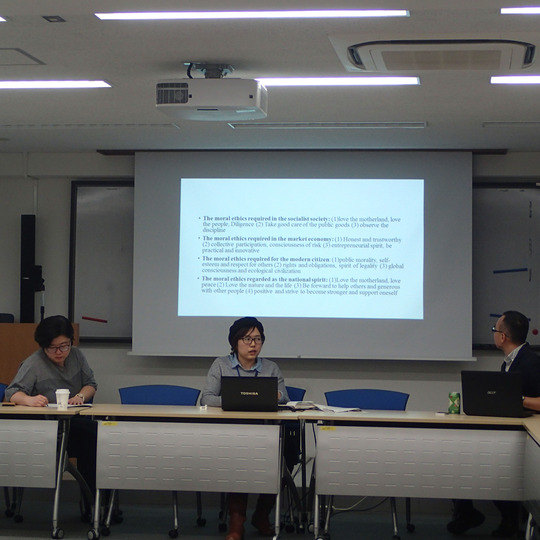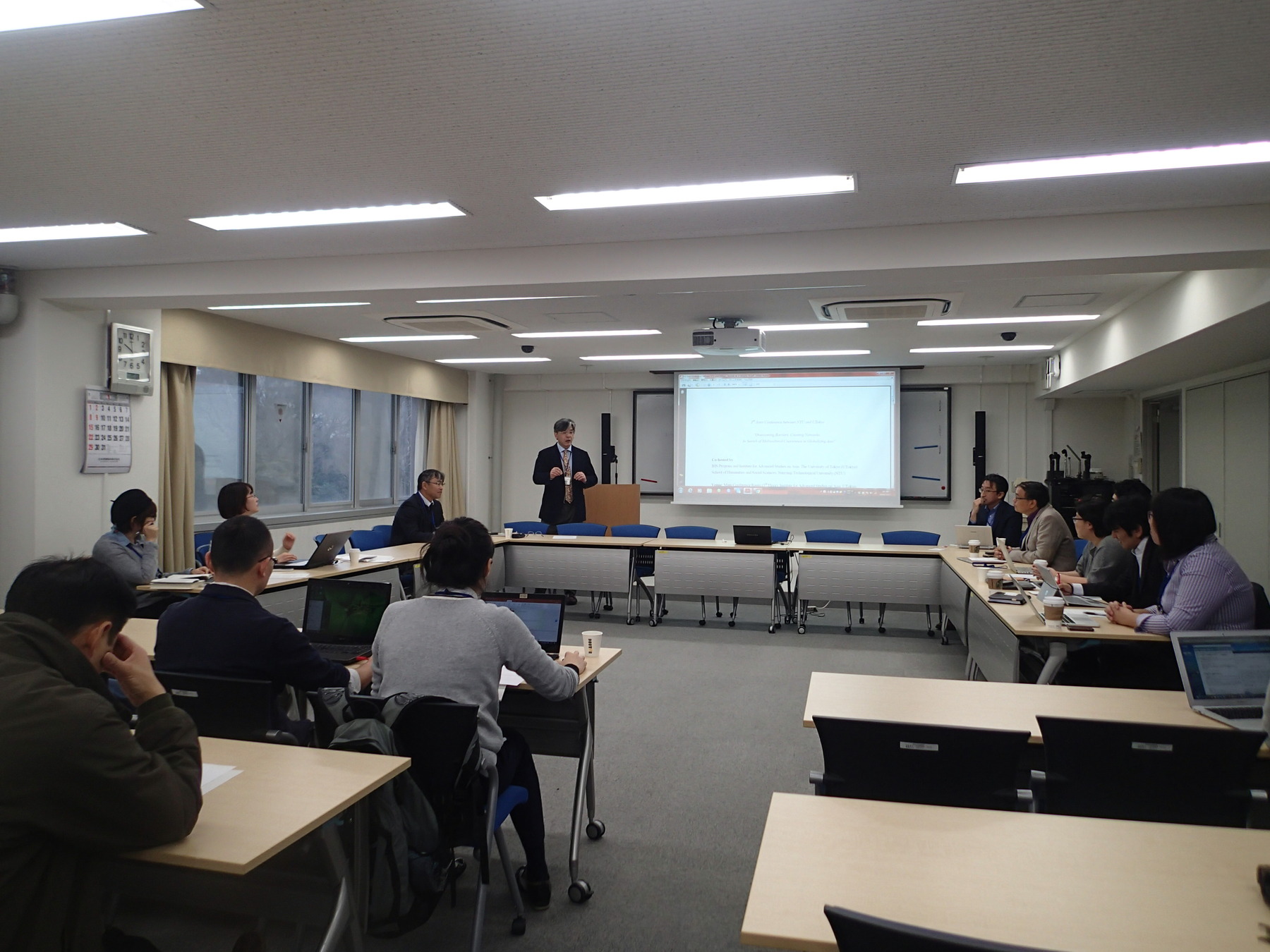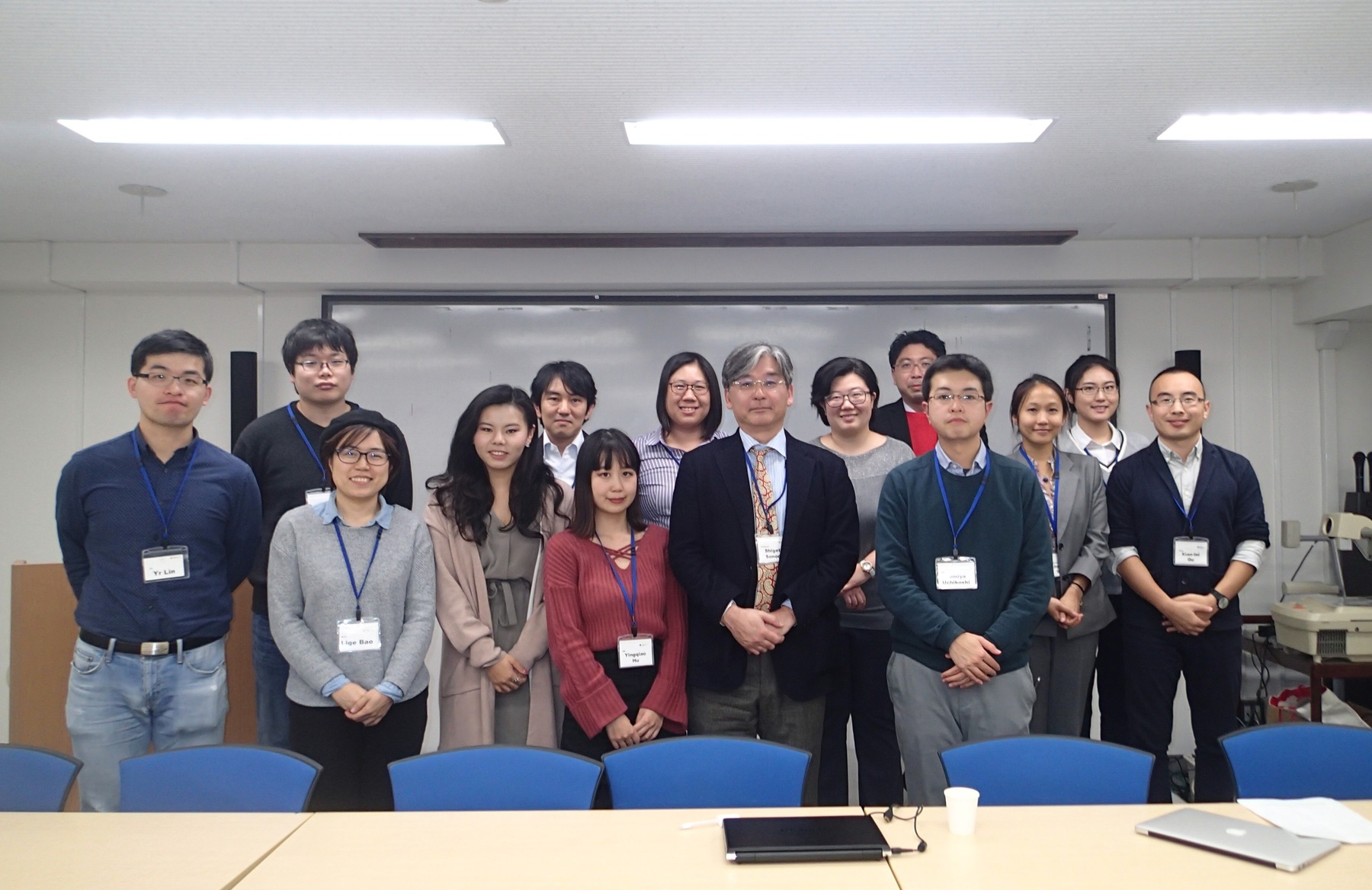
Report: 3rd Joint Conference between NTU and UTokyo “Overcoming Barriers, Creating Networks: In Search of Multicultural Coexistence in Globalizing Asia” Lige BAO
- Time and Date
- 9:30-18:00, January 20 (Fri.), 2017
- Location
- Main Conference Room, 3rd Floor, Institute for Advanced Studies on Asia, Hongo Campus
- Organized by
- The Educational Project 4 “Producing Multicultural Communities,” Integrated Human Sciences Program for Cultural Diversity, The University of Tokyo
This joint conference between NTU and UTokyo has been successfully held for the third time and this time the theme has been set as “Overcoming Barriers, Creating Networks”. The welcome remark was made by Professor Takahiro Nakajima, deputy director of IASA, followed by opening remarks by Prof. Liu Hong, Chair of the School of Humanities and Social Sciences of NTU, and Prof. Shigeto Sonoda, Deputy Director General, Division of International Affairs of UTokyo. They all mentioned the significance of this network creation and the imagination needed to overcome the current obstacles existing in the academia.

A very fruitful discussion was also held in the following roundtable session with the attendance of Professor Chou Meng-Husan, Jin Sato, Koh Keng We and Yoko Nii. The professors, who are from various disciplines, talked about their own opinions of creating new Asian Studies by overcoming traditional intellectual boundaries, reflecting on what could be new and what could be overcome.
For example, Professor Sato questioned the concept of “competition” derived from the theory of the survival of the fittest and pointed out that the existing problems created by the adoption of competition as the basis for economic theories remain largely unattended. Professor Nii tackled this question by relating it to her own research on China. She found that in most cases, the discussions on the Sino-Western interactions have entirely focused on the receptive aspect. On the contrary, scholarly studies have long been overlooking how Chinese knowledge spread and developed outside of China, and more so in the global context. In order to overcome this boundary, she raised the example of the reports Jesuits missionaries sent from China to Europe, not only as a good example of the expansion of the Chinese intellectual history outside the boundary of China, but also an interesting example of the interaction between Chinese and European intellectual world beyond the traditional boundaries of both Chinese and European intellectual history. Similar discussion is also shared by Professor Koh talking about the study on maritime trade, its interdisciplinary approaches and transnational collaborations. Professor Chou also shared her own experience doing collective research on International Relations in NTU. They all shared the same opinion that all these obstacles in the current academia, while often regarded as challenges, are indeed valuable opportunities for potential new findings.
In the afternoon, three sessions of graduate student presentations were held.
First session was titled “New Directions for China Studies”. Xiao Lei Qu from NTU made a presentation on “Making a Temple ‘Prosper’: Religious Competition in Two Popular Religious Temples in Fujian, Southeast China”. He examined religious competition between two temples devoted to Baosheng Dadi (“保生大帝”, The Great Emperor Who Protects Life) in the south-eastern Chinese cities of Xiamen and Zhangzhou. It presented the idiom of “prospering a temple” as an alternative to the religious economy model to account for the vicissitudes of Chinese popular religion. Also the example of intra-religion competition showed how local religious elites have employed means of “selective highlighting” and “authority building” to negotiate with local state and trans-boundary/transnational actors, which in turn shaped and reconfigured trans-boundary/transnational religious networks. In contrast to recent studies focusing on competition between exclusive (e.g. Christianity) and nonexclusive religions, this article showed that fierce competition often occurs among popular religious temples that worship the same deity. Lige Bao from UTokyo gave a presentation on the “Moral Education Reform in China after the “Reform and Opening up” (改革開放) through Policy Analysis” This study demarcated the three changing periods in the Chinese Moral education. The relationship and balance of public morality and private morality was analyzed within these changes. The case of Singaporean moral education situation was also taken into consideration to contrast with the new perspective in the Chinese case. The third presenter was Yuan Li with her presentation on “Are Collateral Relative Losing Their Significance? : A New Agenda for Contemporary Chinese Family Studies”. The size of modern Chinese families is shrinking and it is said that Chinese families are losing the connection with collateral relatives, but Li questioned the notion whether collateral relatives are losing their significance. Most of the current researches have been focused on lineal relatives, so her research put forward a new perspective of value to collateral relatives.

The session (2) was entitled “In Search of Asia-based Social Research”. Yuta Shimada made an introduction of his research on the therapy culture in Japan and connected the research with sociology and psycho-analysis. Tomoko Terade made an presentation titled “Intentional Ambiguity?--A Historical Inquiry to Tokyo Bay Area”. She discussed the large-scale urban development in Tokyo Bay Area started since the late 1970’s. The Ministry of Land, Infrastructure, Transport and Tourism and Tokyo Metropolitan Government have given different names to Tokyo Bay Area. For that reason, she compared names used in 1980’s magazines with 1990s administrative terms, focusing on the concept of “WATER FRONT”, to have a better understanding of the ambiguous definitions of these names. The following presenter Yingqiao, using the key concept “role category of youth”, reviewed the “fan subs” (TV drama, animation, or variety shows subtitles created by fans) in the contemporary China. She mentioned that Fan-sub in China is not a counter-culture, but rather a culture filled with “good kids”. These kids have a tendency to follow the external rules, doing the “correct things” rather than letting their internal personality flow. Thus she argued that to study Chinese youth and their culture, borrowing theories from western country without critical thinking is not an appropriate and effective way. She further argues that in future studies, it is absolutely necessary to contextualize the problem and put the focus back onto the Chinese youth themselves.
The last session was made with the theme “International Dimensions of Changing Asian Societies”. Ma Sirui made a presentation with the title “Through the ‘Chinese Bridge’: Performing Chinese Culture in Thailand’s Confucius Institute”. Confucius institutes (CIs) are widely regarded as, whether successful or not, an attempt to boost Chinese soft power. However, she argued that a closer look at the situation on the ground shows that soft power per se may not offer a sufficient explanation to the impetus of the global CI network. She took Thailand as an example to illustrate the coexistence and interdependence of the multi-layered interests of participants in the CI-related activities, and then asked who has power in the creation of networks and of defining the multicultural coexistence, and who gets the benefit. Her research gave a rather fresh look at the China study in the global setting. The last presenter Fumiya Uchikoshi shared his quantitative research aimed to identify the structure of ethnic hierarchy, a cumulative pattern of preference toward foreigners shared by the natives in the host society, in a comparative perspective within eight Asian countries by using the dataset of Asian Student Survey 2013. His research is rather new in that while there have been researches on ethnic hierarchy in Japan, Korea, Taiwan and China, his finding is one of the first to comprehensively include Southeast Asian countries and Southeast Asians in the analysis. Also, this article aims to evaluate whether ethnic hierarchy observed at the country level is similar to that at the individual level in the country.
This joint conference has brought various new approaches to the area studies, and new questions are raised for the following researches. What should be emphasized starting from this conference is just as the theme suggests, “keep creating networks and keeping trying to overcome barriers.”

report date : January 30th , 2017
